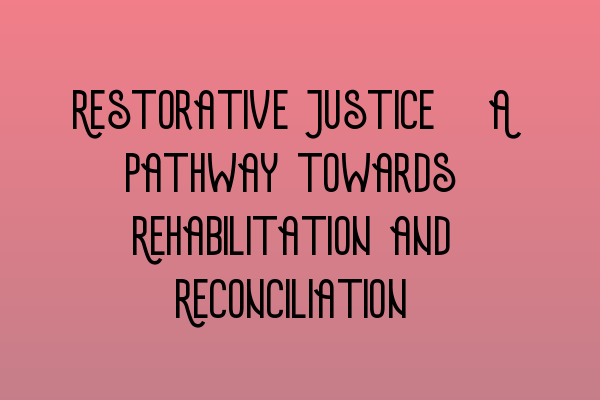Restorative Justice: A Pathway towards Rehabilitation and Reconciliation
Restorative justice is a concept that focuses on repairing harm caused by criminal behavior and fostering reconciliation between the offender, the victim, and the community. It is a process that seeks to address the underlying causes of crime and provide an opportunity for the offender to make amends and reintegrate into society.
Understanding Restorative Justice
Restorative justice emphasizes the importance of engaging all parties affected by a crime – the victim, the offender, and the community – in a dialogue that aims to find a resolution that promotes healing and understanding. It shifts the focus from punishment to rehabilitation, recognizing that punitive measures alone may not lead to long-term behavioral change.
By involving the victim in the process, restorative justice gives them a voice and an opportunity to express their feelings, ask questions, and receive answers directly from the offender. This can provide a sense of closure and empower the victim to cope with the trauma caused by the crime. Additionally, it allows offenders to recognize the impact of their actions, take responsibility, and actively participate in repairing the harm they have caused.
The Benefits of Restorative Justice
Restorative justice offers several benefits compared to traditional criminal justice approaches. Firstly, it promotes healing and reconciliation, which can contribute to reducing anger, resentment, and further acts of violence. Victims can find solace in having their questions answered and seeing offenders take responsibility for their actions.
Secondly, restorative justice encourages empathy and understanding. By facilitating open communication between the victim and the offender, it helps humanize each party and allows them to see each other as individuals with complex circumstances, rather than simply as adversaries. This can foster empathy and a greater understanding of the root causes of crime.
Thirdly, restorative justice focuses on rehabilitation rather than punishment. It recognizes that offenders are more likely to change their behavior when they have the opportunity to engage in meaningful dialogue, take responsibility, and actively work towards making amends. This approach can lead to lower recidivism rates and a more effective criminal justice system.
Implementing Restorative Justice
Restorative justice can be implemented in various stages of the criminal justice process, from pre-trial to post-conviction. Mediation or conferencing sessions may take place where victims, offenders, and community members come together to discuss the harm caused and explore potential solutions. These sessions are facilitated by trained professionals who ensure a safe and respectful environment for all participants.
To fully leverage the benefits of restorative justice, it requires a comprehensive approach that integrates support services such as counseling, educational programs, and vocational training. These resources help offenders address the underlying causes of their criminal behavior and develop skills necessary for successful reintegration into society.
Restorative justice is not meant to replace traditional criminal justice practices entirely. Rather, it should be seen as a complementary approach that can be used alongside punitive measures, especially in cases where the offender and the victim are willing to participate.
SQE 1 Practice Exam Questions,
SQE 1 Practice Mocks FLK1 FLK2,
SQE 2 Preparation Courses,
SQE 1 Preparation Courses,
SRA SQE Exam Dates.
